January 2, 1922- The "Dixie Classic"- Centre Vs. Texas A&M

Headline announcing the first "Dixie Classic"
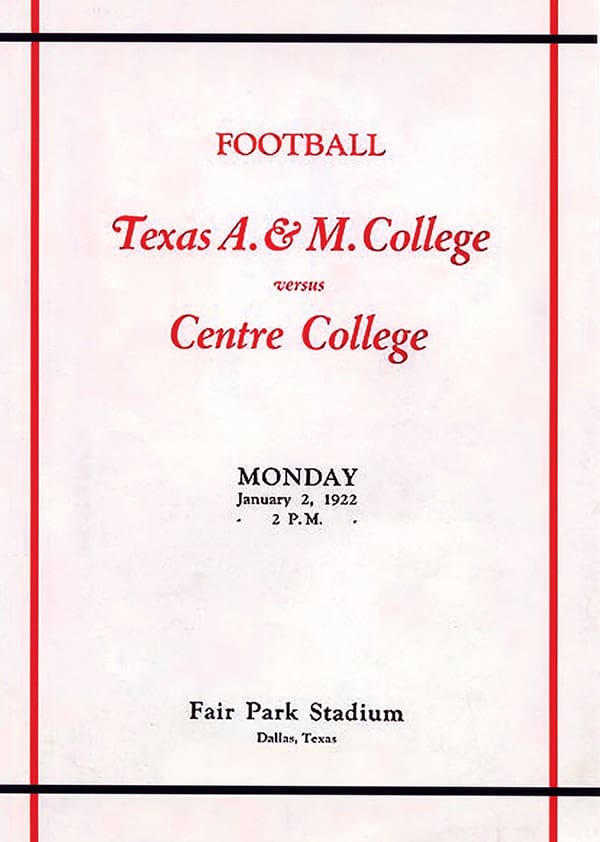
Program in possession of the author
Bo bought his new bride to the game after the wedding and brought her out on the field and proudly showed her off to the crowd as photographers clicked away. It was obvious that after all of these years of waiting to get married, the happy couple was relishing the moment and in a celebratory mood.

Bo and his long-time girlfriend Marie Miers, and now bride
The two team captains, "Henie" Weir and Red, met at midfield for the toss which was won by A&M, and the Dixie Classic was ready to begin. Red put the ball near the Aggies' goal, Sammy Sander returned it 40 yards, and A&M went on the attack. Centre played tough, gave up no yardage, and A&M had to punt.
Torn Bartlett fielded the ball on the 2 yard line and tried to evade the on rushing defenders by moving laterally, and as he stepped just behind his goal line, a diving Aggie tripped him up and he fell just behind the marker.
An official raced over and declared that it was a safety since Bartlett had been downed in his own end zone.
With just a couple of minutes run off the clock, it was Texas A&M up 2-0, much to the delight of the partisan crowd.
The points were the first surrendered by the Colonels since the St. Xavier game on October 15, slightly over 2 ½ months and 8 games ago. While the points were obviously a disappointment, the concern wasn't about being down by 2, but was about seeing Red limping. The captain had taken out a maroon and white clad Texan and gone for a second block when he cut sharply and fell to the ground in obvious discomfort.
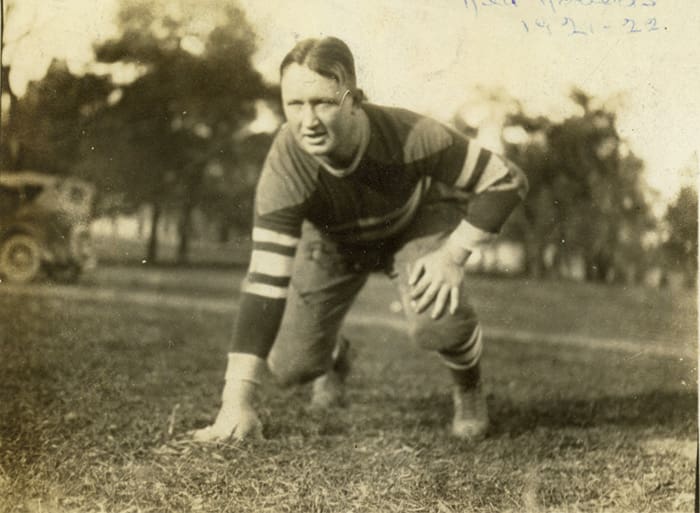
Red Roberts who was injured early in the game
Red got up and continued to play, but it was obvious from that moment on that he wouldn't be able to be as effective as normally.
It wasn't particularly a good start. Down by 2, and Red with a hurt knee.
Army told me later, and Hump did too, that despite Red being hurt, they weren't too worried. I guess it's human nature to sometimes underestimate an opponent. Our guys realized that they had just toyed with Arizona and still won, 38-0. They couldn't help but realize that Texas A&M had been hard pressed to beat Arizona, 17-13, even on its home field. The papers had mentioned that fact in story after story, and the betting had us as 4-1 favorites. But of course, games are won on the field, and not in the papers.
Centre dominated play the rest of the first half.
There were 3 series when the Colonels had great field position and should have scored.
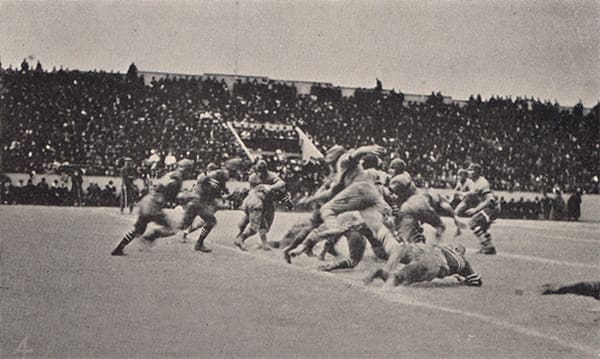
Colonels running a play in a packed stadium
After a Centre punt, Sammy Sanders caught the ball, juggled it, and the ball hit the ground. As he tried to pick it up he was hit Bill Shadoan who was running at full speed. Sanders was knocked totally unconscious, "the ball dropping from his nerveless fingers."
Shadoan pounced on the ball on the Aggie 28.
Three plunges gained 7, then A&M was whistled for holding and the 15 yard penalty resulted in the ball being marched to the Aggies' 6, and it was 1st and goal.
First Bo, then Snowday, then Army hit the line, and the ball rested on the 6 inch line.
On the 4th play, Bo fumbled the snap and the delay caused him to just get back to the line of scrimmage. Texas A&M took over and decided to punt it away.
Herb Covington was in the game and caught the punt and couldn't advance, but the Colonels were starting on the Aggies' 40 yard line.
Bo hit Covington for 15 and the little speedster picked up another 10, and it was 1st down Centre on the 15.
Centre moved to the 9, and Bo fumbled and A&M recovered.
It was the 2nd time that it appeared the Colonels were going to put points on the board and they had nothing to show for their efforts. The offense that Uncle Charlie had installed depended on split timing. He had his team run signal drills over and over, perfecting the precision of the offense which the young reporter in New Orleans had been so awed by when the Colonels ran plays at a practice before the Tulane game.
The lack of practice time on the long trip, and Bo having missed much of the practice sessions in Dallas, was beginning to show.
The Colonels simply weren't sharp.
Still, Centre was paying its usual tenacious defense. After the Aggies recovery of Bo's second fumble, they couldn't move the ball and had to punt again, and Herb Covington returned the ball to the A&M 28.
The Colonels had great field position again and went back on the attack picking up a couple of yards on the ground before Bo went to the air.
His first pass was incomplete. The 2nd picked up 5. With 4th and 5, Bo's pass was picked off as he tried to pick up the 1st down.
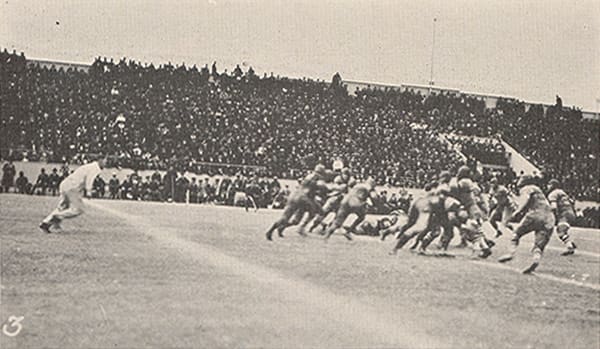
On the attack again
Two fumbles and an interception after 3 possessions begun well into A&M territory.
There was an exchange of punts and the half, the very frustrating half in which nearly the entire action had taken place in A&M territory, ended with the safety being the only score.
It was 2-0.

Bryan, the twin city of College Station, home of the Aggies
As the two teams left the field for the break, the Texas A&M Cadet Band, 30 strong, marched onto the field and formed a "T" and played the school song.
The "Aggie War Hymn" had been written by J.V. "Pinky" Wilson while he was standing guard with the American Expeditionary Force on the Rhine right after the Great War.
"The Aggie War Hymn"
All hail to dear old Texas A&M!
Rally around Maroon and White.
Good luck to the dear old Texas Aggies.
They are the boys who show the real old fight.
That good old Aggie spirit thrills us
And makes us yell and yell and yell.
So let's fight for dear old Texas A&M.
We're goin' to beat you all to
Chig-gar-roo-gar-rem!
Chig-gar-roo-gar-rem!
Rough Tough! Real Stuff! Texas A&M!
(Chorus)
Hullabaloo, Caneck ! Caneck!
Hullabaloo. Caneck ! Caneck !
Then the full dress-uniformed Cadets played "My Old Kentucky Home" in honor of the Colonels and their fans.
Red Roberts had hardly been a factor in the 1st half. Unless a run came right over his position, he seemed to be unable to move toward the play, and his interference was lacking on offense. It wasn't from lack of effort of the big redhead. No one could ever say Red didn't have heart. But the fact that his knee was so swollen from the injury early in the game severely limited his mobility.
It was like in the Harvard and Georgia Tech games of 1920. The Colonels weren't able to play up to their expected level without a fully functional Red. He continued to play the entire game, never going to the sidelines, but he and Centre were tremendously handicapped by his swollen, painful knee.
Texas A&M had its own share of injuries. Two starting backs hadn't even suited up due to injuries suffered during earlier games, and their captain and fullback "Henie" Weir, was carried off the field early during the 1st quarter by Coach D. X. Bible and his staff with what was discovered later to be a broken leg.
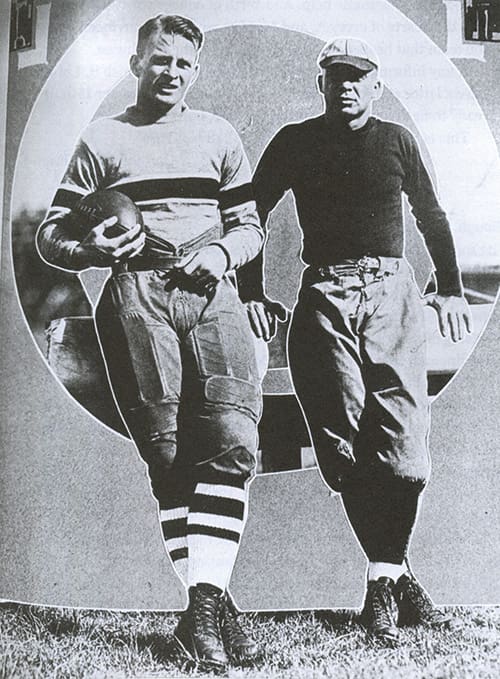
Henie Weir and Coach D. X. Bible
The lack of manpower on the part of the Aggies resulted in one of the most endearing, and enduring, traditions in all of college football.
Coach Bible began to worry about having anyone to substitute as the injuries kept piling up. It was a hard-hitting game. Thus was born the fabled "12th Man" tradition.
E. King Gill was a former Aggie football player who left the team after the end of the regular season and decided to concentrate full time on basketball. He was in the press box helping to identify players for the writers covering the game.
Coach Bible sent someone up to the press box who told Gill that the coach wanted him to hustle down to the bench and get suited up. The messenger sent by Coach Bible told Gill that so many backs had been injured, he may be needed.
Gill got the uniform which the injured Henie Weir had been wearing and went under the stadium to suit up.
Gill stayed on the sidelines and watched the action continue to unfold.
He stood by, ready to help if needed.

E. King Gill
Gill was later quoted as saying, "I wish I could say that I went in and ran for the winning touchdown. But I did not. I simply stood by in case my team needed me."
This gesture by Gill was more than enough for the Aggie team. Although he didn't play in the game, he had accepted the call to help in any way possible. He came to be known as the "12th Man," because he stood ready to help in the event that the eleven men on the gridiron needed assistance. That spirit helped kindle a flame of devotion among the whole student body that lives to this day. The entire A&M student body now is the "12th Man," and 38,000 students in the stadium now stand throughout the entire football game to show their support.

The student body standing throughout a game

The tradition in the 1950's
King Gill is immortalized by a bronze statue presented to Texas A&M University by the class of 1980 which stands outside of Kyle Field.
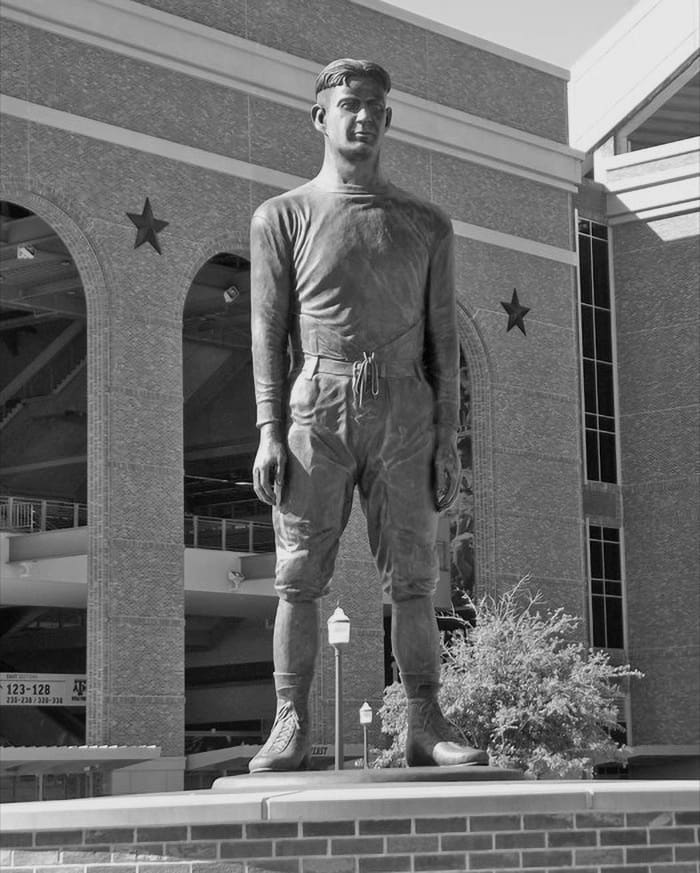
Statue of King Gill at Kyle Field
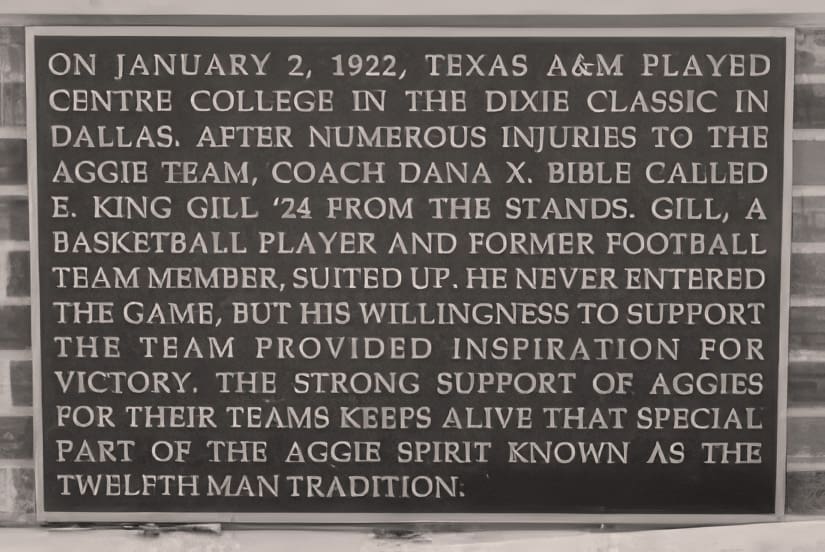
To this day, the tradition at A&M lives. The 12th Man Shop carries articles commemorating that event which occurred now over a century ago.
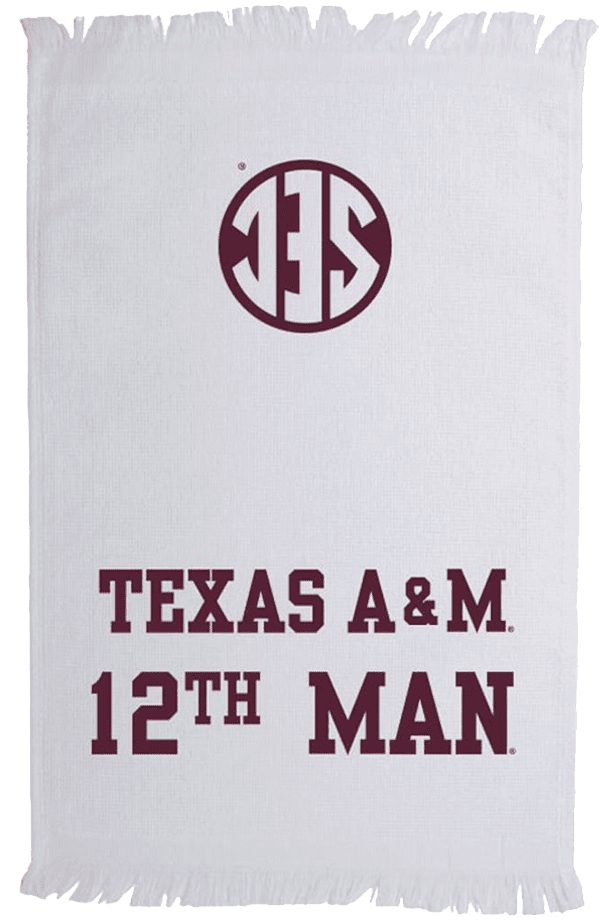
The tradition lives on
After the halftime break, the game resumed with the crowd amazed that Centre, the number 1 team in the country, the team which had defeated Harvard, the team that had given up only 6 points all year, was coming back onto the field trailing, even if it was only by 2-0.
The 3rd quarter was a defensive contest featuring exchanges of punts, neither team giving ground. With 5 minutes left in the period, Centre got a break when the Aggies' Tom Miller fumbled, and Hump Tanner scooped up the ball on the 32 yard line and lugged it down to the 3 before being bumped out of bounds.
Centre lined up, determined not to blow another chance, and Snowday literally went through the air, leaping over the mass of Texans defending their goal. Red kicked the extra point and Centre finally had broken through. It was 7-2.
The Centre College Colonels were just a little over 19 minutes from an 11-0 perfect season and a sure claim for a national championship.
Then disaster.
Coach Bible decided to kickoff. His team hadn't been able to move the ball on the Colonels who had been displaying their customary, impregnable defense. It was a wise coaching call.
The kick wasn't deep and went to Bill James who brought it to the 33 and fumbled when he was hit by the same Miller whose bobble set up the Colonels' score. It seemed to be poetic justice, a way for the young Aggie to redeem himself.

Tom “Louie” Miller who recovered Bill James’s fumble which set up the Aggie’s’ first touchdown
On the 2nd play from scrimmage, the Texans lined up and ran a triple pass play when their halfback, somewhat confusingly named McMillan, passed to T.F "Puny" Wilson, who passed to Miller, who put the ball in the air, 40 yards to Evans, who scored. The extra point made it 9-7, Texas A&M.

"Puny" Wilson, a critical link in the Aggie's first TD
The Colonels held the lead less than a minute.
The second Aggie touchdown came with equal suddenness.
Herb Covington received the kickoff and returned it to his own 24. Two plunges went nowhere against the fired-up A&M defense, and then "Covey" fumbled and it was recovered by the Aggies. Four plays later, Wilson raced around Red who simply couldn't move laterally and dashed into the end zone. The extra point made it 16-7, which is how the 3rd quarter ended.

The touchdown made it 16-7 for A&M which ended up assuring the Aggies' win. Bill James ( 10 ) is at the right and Red Roberts ( 29 ) is in the center of the photo. Red had worn #24 in the Harvard game.
The momentum had definitely shifted, and things were looking serious.
Early in the 4th quarter, Bo had his team on the Aggies 40 yard line. He knew that if his team could score, kick the extra point, and then put 3 points on the board with a field goal, they could pull it out, 17-16. It certainly wasn't beyond what the Colonels were capable of doing if their offense was clicking.
Bo decided to go to the air. His line gave him perfect protection and he raced back and forth, getting further and further back behind the line of scrimmage when he finally fired a desperation pass which was picked off by a maroon and white-clad Ted Winn, who returned it 45 yards for a touchdown. The extra point was no good, but Centre was down 22-7, and things were looking more than serious for the Gold and White.
They were actually looking really bad.
The Colonels fought back, refusing to go down without giving it everything they had.
The kickoff was returned to the Colonels' 30. Bo hit Red for 20 and then 16. Bo called 6 straight ground plays with freshman "Case" Thomasson, who had replaced Terry Snowday, carrying the ball each time. With the ball on the 18, Bo hit Snowday, who had checked back in, for the final 18, and Red's kick made it 22-14.
In the few minutes remaining, Bo tried runs, fired passes left and right, long and short, but couldn't connect on a score, and the final margin was 22-14.

The Kentuckians picked up 14 first downs to but 5 for the Aggies. The Colonels gained 314 yards, usually sufficient for a win. Herb Covington picked up 137 yards on 22 carries and was easily the best man on the field on January 2, 1922, accounting for over 40% of Centre's yardage.
The combination of Centre's fumbles and intercepted passes proved fatal. Statistically, the Colonels were the better team, but games are settled on the scoreboard.
The Texas Aggies never had a sustained drive, but they won, and the Colonels accepted the loss in the manner in which they had accepted their victories.
They were never arrogant or bragged when they won.
The rare times when they lost, they offered no excuses.
The Colonels stood at midfield after the final whistle and gave a "Hip, Hip, Hooray for the Aggies. Hip, Hip, Hooray for the Aggies."
It was an appropriate way to end the Dixie Classic.
